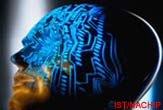
The line between living organisms and machines has just become a whole lot blurrier. European researchers have developed "neuro-chips" in which living brain cells and silicon circuits are coupled together.
The achievement could one day enable the creation of sophisticated neural prostheses to treat neurological disorders or the development of organic computers that crunch numbers using living neurons.
To create the neuro-chip, researchers squeezed more than 16,000 electronic transistors and hundreds of capacitors onto a silicon chip just 1 millimeter square in size.
They used special proteins found in the brain to glue brain cells, called neurons, onto the chip. However, the proteins acted as more than just a simple adhesive.
"They also provided the link between ionic channels of the neurons and semiconductor material in a way that neural electrical signals could be passed to the silicon chip," said study team member Stefano Vassanelli from the University of Padua in Italy.
The proteins allowed the neuro-chip's electronic components and its living cells to communicate with each other. Electrical signals from neurons were recorded using the chip's transistors, while the chip's capacitors were used to stimulate the neurons.
It could still be decades before the technology is advanced enough to treat neurological disorders or create living computers, the researchers say, but in the nearer term, the chips could provide an advanced method of screening drugs for the pharmaceutical industry.
Get the world’s most fascinating discoveries delivered straight to your inbox.
"Pharmaceutical companies could use the chip to test the effect of drugs on neurons, to quickly discover promising avenues of research," Vassanelli said.
The researchers are now working on ways to avoid damaging the neurons during stimulation. The team is also exploring the possibility of using a neuron's genetic instructions to control the neuro-chip.
 Live Science Plus
Live Science Plus





